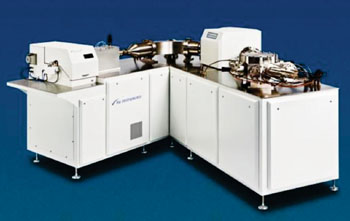Zinc Isotope Test Helps Detect Early Breast Cancer
By LabMedica International staff writers
Posted on 24 Dec 2014
It may be possible to detect the early signs of breast cancer with a test that measures changes in zinc isotopes as measurable changes in zinc isotope composition can be detected in breast tissue and could be used as a biomarker for early breast cancer.Posted on 24 Dec 2014
Breast cancers that are found after they start to cause symptoms, for example, a new lump or swelling, or changes in nipple shape and texture, are usually larger and more likely to have started spreading than breast cancers found before symptoms emerge. The size of a breast tumor and how far it has spread are two of the most important factors in predicting the success of treatment and the longer-term outlook for the patient.

Image: The Nu Plasma II multiple collector inductively coupled plasma mass spectrometry instrument (MC-ICP-MS) (Photo courtesy of Nu Instruments).
Scientists at the University of Oxford (UK) determined the zinc concentrations and isotopic composition of blood and blood serum of healthy controls and breast cancer patients, alongside a suite of 10 breast tissues, predominantly obtained from breast cancer patients. They applied techniques normally used by earth scientists to understand climate change and the birth of planets, to study how the body processes metals.
The techniques which are over 100 times more sensitive to changes in metal composition than any clinical laboratory instruments, measure the levels of trace metals in terms of the relative proportions of their different isotopic forms.
Zinc and copper concentrations were determined by multiple collector inductively coupled plasma mass spectrometry (MC-ICP-MS) and inductively coupled plasma atomic emission spectroscopy (ICP-AES). Isotope analyses were performed using the Nu Instruments Nu Plasma HR MC-ICP-MS at the appropriate resolution mode (Copper: low, Zinc: medium) with either an Aridus (Cetac; Omaha, NE, USA) or a desolvating sample system (DSN) (Nu Instruments, Oxford, UK). The reproducibility of the methods was monitored by repeat measurements of an in house standard alongside sample.
The investigators found that the breast cancer tumors had a significantly lighter zinc isotopic composition than the blood, serum and healthy breast tissue of both the breast cancer patients and the healthy controls. The team suggests the subtle differences in zinc composition occur because tumor cells process the metal differently to normal cells. They also found similar changes in copper in one of the breast cancer patients.
Fiona Larner, PhD, the lead author of the study, said, “We have known for over 10 years that breast cancer tissue carries high levels of zinc, but the underlying processes that cause this are not well understood. Our study shows that techniques commonly used in earth sciences can help us to understand not only how zinc is used by tumor cells but also how breast cancer can lead to changes in zinc in an individual's blood. Further research is already under way to see what changes in other metals may be caused by other cancers.” The study was published on December 1, 2014, in the journal Metallomics.
Related Links:
University of Oxford
Cetac
Nu Instruments













